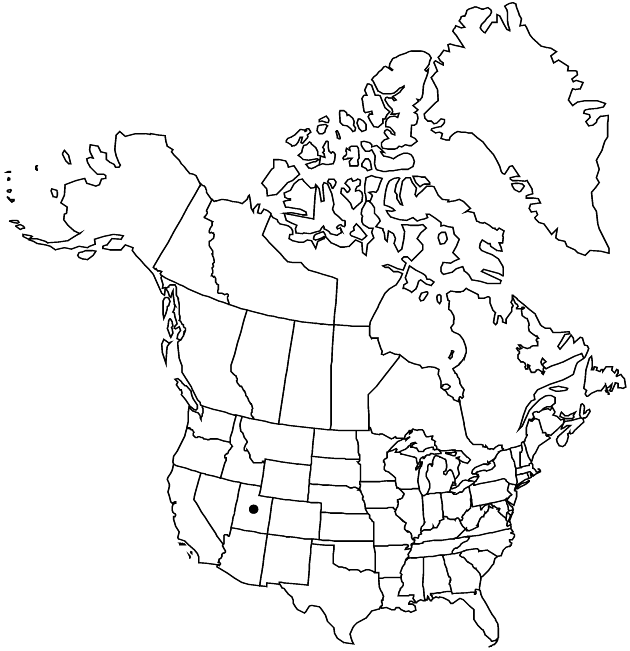Difference between revisions of "Erigeron untermannii"
Great Basin Naturalist 43: 367. 1983.
FNA>Volume Importer |
imported>Volume Importer |
||
| (6 intermediate revisions by 2 users not shown) | |||
| Line 8: | Line 8: | ||
}} | }} | ||
|common_names=Indian Canyon fleabane | |common_names=Indian Canyon fleabane | ||
| + | |special_status={{Treatment/ID/Special_status | ||
| + | |code=E | ||
| + | |label=Endemic | ||
| + | }}{{Treatment/ID/Special_status | ||
| + | |code=C | ||
| + | |label=Conservation concern | ||
| + | }} | ||
|basionyms= | |basionyms= | ||
|synonyms={{Treatment/ID/Synonym | |synonyms={{Treatment/ID/Synonym | ||
|name=Erigeron carringtoniae | |name=Erigeron carringtoniae | ||
|authority=S. L. Welsh | |authority=S. L. Welsh | ||
| + | |rank=species | ||
}} | }} | ||
|hierarchy=Asteraceae;Asteraceae tribe Astereae;Erigeron;Erigeron untermannii | |hierarchy=Asteraceae;Asteraceae tribe Astereae;Erigeron;Erigeron untermannii | ||
| Line 28: | Line 36: | ||
|distribution=Utah. | |distribution=Utah. | ||
|discussion=<p>Of conservation concern.</p><!-- | |discussion=<p>Of conservation concern.</p><!-- | ||
| − | --><p>Rays of Erigeron untermannii tend to both coil and reflex, emphasizing its apparent close relationship to E. caespitosus. The leaves are often spatulate and glabrous to glabrate abaxially, features more similar to E. radicatus and its close relatives. Hybrid parentage is a reasonable hypothesis.</p> | + | --><p>Rays of <i>Erigeron untermannii</i> tend to both coil and reflex, emphasizing its apparent close relationship to <i>E. caespitosus</i>. The leaves are often spatulate and glabrous to glabrate abaxially, features more similar to <i>E. radicatus</i> and its close relatives. Hybrid parentage is a reasonable hypothesis.</p> |
|tables= | |tables= | ||
|references= | |references= | ||
| Line 37: | Line 45: | ||
-->{{#Taxon: | -->{{#Taxon: | ||
name=Erigeron untermannii | name=Erigeron untermannii | ||
| − | |||
|authority=S. L. Welsh & Goodrich | |authority=S. L. Welsh & Goodrich | ||
|rank=species | |rank=species | ||
| Line 51: | Line 58: | ||
|publication title=Great Basin Naturalist | |publication title=Great Basin Naturalist | ||
|publication year=1983 | |publication year=1983 | ||
| − | |special status= | + | |special status=Endemic;Conservation concern |
| − | |source xml=https:// | + | |source xml=https://bitbucket.org/aafc-mbb/fna-data-curation/src/2e0870ddd59836b60bcf96646a41e87ea5a5943a/coarse_grained_fna_xml/V19-20-21/V20_583.xml |
|tribe=Asteraceae tribe Astereae | |tribe=Asteraceae tribe Astereae | ||
|genus=Erigeron | |genus=Erigeron | ||
Latest revision as of 21:04, 5 November 2020
Perennials, 2–8 cm; taprooted, caudices branched, retaining old leaf bases. Stems erect (greenish proximally, essentially scapiform), strigose, eglandular. Leaves mostly basal (persistent); blades oblanceolate to spatulate, 10–50 × (1–)2–5(–7) mm, sometimes continuing on proximal 1/2 of stems, margins entire, faces usually sparsely to densely strigose, abaxial sometimes glabrous or glabrate, eglandular. Heads 1. Involucres 5–7 × 6–12(–15) mm. Phyllaries in 2–3(–4) series, densely hispiduloso-hirsute, eglandular. Ray florets 14–30; corollas white to pink or purplish, 4–8 mm, laminae coiling and reflexing. Disc corollas 3.5–5 mm. Cypselae 2.3–3 mm, 2-nerved, faces and margins moderately strigose to strigoso-sericeous, margins densely ciliate; pappi: outer of setae, inner of 18–35 bristles.
Phenology: Flowering May–Jun.
Habitat: Exposed sites, calcareous shale, limestone, sandstone, or marly gravel, meadows, pinyon-juniper, mountain mahogany, limber and bristlecone pine, sagebrush
Elevation: 2100–3400 m
Discussion
Of conservation concern.
Rays of Erigeron untermannii tend to both coil and reflex, emphasizing its apparent close relationship to E. caespitosus. The leaves are often spatulate and glabrous to glabrate abaxially, features more similar to E. radicatus and its close relatives. Hybrid parentage is a reasonable hypothesis.
Selected References
None.
